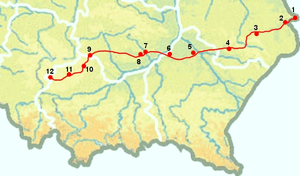Hrubieszów–Sławków Południowy LHS railway
| Broad Gauge Metallurgy Line | |||
|---|---|---|---|
 ST40s on the Broad Gauge Metallurgy Line. | |||
| Overview | |||
| Type | Freight | ||
| System | UIC60 | ||
| Locale | Southern Poland | ||
| Termini |
Bug River Bridge (Poland-Ukraine border) Sławków | ||
| Stations | 6 | ||
| Services | 1 | ||
| Operation | |||
| Opened | Construction commenced November 15, 1976, opened November 30, 1979 | ||
| Owner | PKP LHS Sp. z o.o. | ||
| Operator(s) | PKP LHS Sp. z o.o. | ||
| Technical | |||
| Line length | 394.65 km (245.22 mi) | ||
| Track length | 600 km (372.82 mi) | ||
| Track gauge | 1,520 mm (4 ft 11 27⁄32 in) | ||
| Electrification | No | ||
| Operating speed | 80 km/h (50 mph) | ||
| |||
Broad Gauge Metallurgy Line (Polish: Linia Hutnicza Szerokotorowa, LHS), is the longest broad gauge railway line in Poland. Except for this line and a few very short stretches near border crossings, Poland uses standard gauge. The single-track line runs for almost 400 km from the Polish-Ukrainian border crossing just east of Hrubieszów to Sławków Południowy (near Katowice). It is used only for freight, mainly iron ore and coal. It is the westernmost part of the broad-gauge network based on the former Soviet Union.
The line is operated by PKP Linia Hutnicza Szerokotorowa Spólka z o.o. company.
Its previous name was Linia Hutniczo Siarkowa (En. Metallurgy - sulphur line), but after sulphur ceased to be transported its name was changed, keeping the initials the same.
History
In the 1970s the new giant Huta Katowice steel mill, then in its most prosperous period, required great quantities of iron ore. The main source was mines near Kryvyi Rih (then in the USSR, now in Ukraine), from where it was transported by rail via Medyka, Przemyśl, and Tarnów to Jaworzno Szczakowa. This line had inadequate capacity to carry the traffic.
PKP considered two plans: to modernise the existing tracks to allow more freight to be carried, or to build a new broad-gauge line to ease transit across the border. The latter was chosen, designed by CBSiPBK (Central Bureau for Railway Construction Designs and Studies) in Warsaw. Eng. Józef Skorupski was the general designer. Twenty-one other design bureaus, eight geological companies and three technical universities took part in the project.
The line opened in 1979 and was used to import iron ore from the USSR and export coal and sulphur. After the fall of communism and the economic changes of 1989 traffic greatly diminished. Various schemes are being tried to increase its profitability.
See also
External links
- PKP LHS company official website URL accessed at February 7, 2006 (Polish)
- LHS fan website URL accessed at February 7, 2006 (Polish)
| Wikimedia Commons has media related to LHS. |
